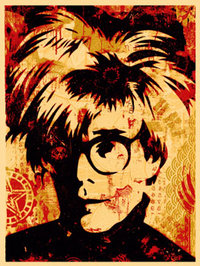Andy Warhol (Difference between revisions)
From The Giant: The Definitive Obey Giant Site
Illyanadmc (Talk | contribs) m |
m |
||
| (6 intermediate revisions by 4 users not shown) | |||
| Line 1: | Line 1: | ||
| − | + | Andrew Warhola (August 6, 1928 – February 22, 1987), better known as [http://en.wikipedia.org/wiki/Andy_Warhol Andy Warhol], was an American artist who was a central figure in the movement known as Pop art. | |
| − | + | He has influenced Shepard Fairey both artistically as well as philosophically, and Fairey has referenced Warhol's work in several of his own pieces. | |
| + | |||
| + | Fairey writes, in [[Supply and Demand Book|''Supply and Demand'']], pg. 223:<br>Warhol, for me, represents an incredibly important step for fine art away from aristocratic elitism. In a world about sophistication and superiority, what a coup to be able to elevate mundane items, to which any poor American had access, to the level of fine art! What an incredible way to refute the elitism of that world and create a dialogue about the role of art in society! Warhol's art was accessible - hence the term "pop art." Warhol also understood the importance of creating a culture around his art and utilizing pop mediums such as music, television, and film to do so. Warhol's connection with the Velvet Underground gave them instant credibility, and gave Warhol an association with a hip, rebellious audience. Warhol's embrace of the media, and his calculated aloofness in their presence, only helped to grow people's fascination with him and his work. Warhol's distance and mystery created room for anyone to make Rorshcach-test-like interpretations of him or his work. Whether people liked or disliked Warhol, he brought up important issues of art and culture. | ||
{| | {| | ||
| − | |[[Image:Marilynwarhol.jpg|thumb| | + | | [[Image:Marilynwarhol.jpg|thumb|200px|[[Marilyn Warhol]]]] || [[image: Andre-warhol2.jpg|thumb|200px|[[Andre Warhol]]]] || [[Image:Allcity.jpg|thumb|200px|[[All City Propaganda]]]] |
|} | |} | ||
| − | + | {| | |
| − | { | + | | [[Image:Warhol.jpg|thumb|200px|[[Warhol]]]] || [[Image:Radicals.jpg|thumb|200px|[[Radicals]]]] || [[Image:Markofthegiant.jpg|thumb|200px|[[Mark of the Giant]]]] || |
| + | |} | ||
Latest revision as of 14:30, 24 July 2008
Andrew Warhola (August 6, 1928 – February 22, 1987), better known as Andy Warhol, was an American artist who was a central figure in the movement known as Pop art.
He has influenced Shepard Fairey both artistically as well as philosophically, and Fairey has referenced Warhol's work in several of his own pieces.
Fairey writes, in Supply and Demand, pg. 223:
Warhol, for me, represents an incredibly important step for fine art away from aristocratic elitism. In a world about sophistication and superiority, what a coup to be able to elevate mundane items, to which any poor American had access, to the level of fine art! What an incredible way to refute the elitism of that world and create a dialogue about the role of art in society! Warhol's art was accessible - hence the term "pop art." Warhol also understood the importance of creating a culture around his art and utilizing pop mediums such as music, television, and film to do so. Warhol's connection with the Velvet Underground gave them instant credibility, and gave Warhol an association with a hip, rebellious audience. Warhol's embrace of the media, and his calculated aloofness in their presence, only helped to grow people's fascination with him and his work. Warhol's distance and mystery created room for anyone to make Rorshcach-test-like interpretations of him or his work. Whether people liked or disliked Warhol, he brought up important issues of art and culture.





